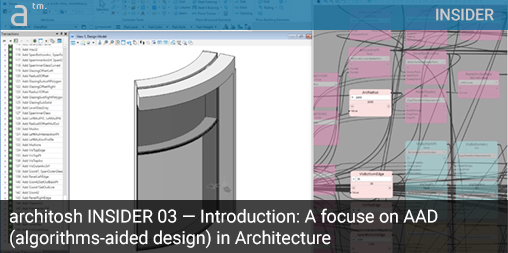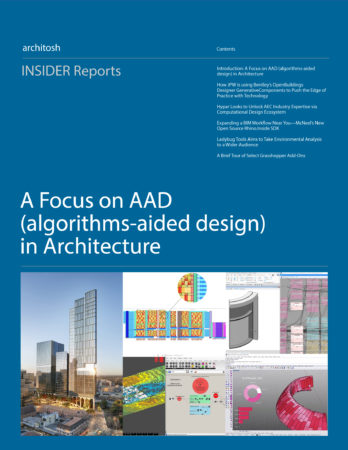WELCOME TO OUR THIRD architosh INSIDER Report—our annual “topically focused” set of special feature articles. This year we do a deep dive into “computational design” developments that are at the leading edge of industry developments.
What You Will Find Inside
The INSIDER brand is meant to signify our best CAD industry journalism and the reports we want our readers to focus on the most. Just as our INSIDER Xpresso brand—in the form of our monthly newsletter—brings exclusive and leading-edge information that readers may not know about, our annual INSIDER Reports feature information and technologies that our readers may not know even existed or were coming.
Most architects are not yet computational design tool users. But AAD tools are becoming critical dimensions to the AEC professional’s workflow. We hope readers find this year’s annual report interesting and valuable. We always love it when you let us know.
Table of Contents:
- Introduction — A Focus on AAD (algorithms-aided design) in Architecture
- How JPW is using Bentley’s OpenBuildings Designer GenerativeComponents to Push the Edge of Practice with Technology
- Hypar Looks to Unlock AEC Industry Expertise via Computational Design Ecosystem
- Expanding a BIM Workflow Near You—McNeel’s New Open Source Rhino.Inside SDK
- Ladybug Tools Aim to Take Environmental Analysis to a Wider Audience
- A Brief Tour of Select Grasshopper Add-Ons
The introduction listed on the report cover graphic in this article (show below) is what you are reading here.
To get a bigger look at the cover graphic click on the image directly above you. Its image pertain to the JPW feature and to the listing of GH plugins in our final feature in the series.
Rhino.Inside
For those readers who are subscribers to our INSIDER Xpresso monthly newsletter, you have already had a chance to read one of the features below on McNeel’s new ‘Rhino.Inside’ SDK developments with particular focus and importance on what that means for Autodesk Revit users but beyond that what Robert McNeel and Daniel Belcher reveal about the technology inside Rhino.Inside itself.
“Expanding a BIM Workflow Near You—McNeel’s New Open Source Rhino.Inside SDK,” takes the reader into the stunning developments behind how McNeel’s developers are creating a way for any BIM/CAD tool to essentially run Rhino + Grasshopper inside that host application’s memory space. Importantly, Rhino.Inside means Grasshopper everywhere—the ability to bring the most popular AAD tool to any BIM platform. Indeed, as one learns in the article, Rhino.Inside is a technology that is likely coming to every single major BIM platform, besides the ones it already is connected to now, at some point in the near future.
Of course, there are catches and complexities. Does Rhino.Inside technology work across platforms? How will Rhino.Inside affect tools like ARCHICAD which already have a bi-directional workflow with Rhino + Grasshopper? What about all the plugins…will they work and come over also? These are some of the great questions answered in this feature. This story is the most detailed information published anywhere on Rhino.Inside technology and we actually have more information to share in a future report headed for Xpresso next in May so be sure to sign-up.
Ladybug and Honeybee. Meet Pollination Cloud
Another feature with information you cannot find anywhere is our in-depth story on the folks behind Ladybug Tools. Founders Mostapha Sadeghipour Roudsari and Chris Mackey do a deep dive with Architosh on what the future holds for their industry-leading building and environmental analysis plugins for Grasshopper.
In this feature we learn about Pollination Cloud, the company’s efforts to bring their Ladybug Tools to the cloud and therefore to bring them both to much larger scales and to other platforms. For those not familiar with Ladybug and Honeybee, both do solar radiation and analysis and simulation and provide architects with actionable insights early in the design stage. The really exciting part of this story is how their technologies have been rewritten in the [+] Project to enable them to be accessible from many more platforms; they are no longer limited to just Grasshopper as a computational design platform but accessible both from the cloud and from within other applications on multiple platforms. Readers will definitely want to take in “Ladybug Tools Aim to Take Computational Design and Analysis to a Wider Audience.”
Unlocking AEC Industry Expertise
Co-founder of Hypar, Anthony Hauck, has spoken to Architosh in the past about his company’s exciting approach to the transmission and democratization of “computational design” and industry expertise. In this second major feature of the company, we learn even more about Hypar’s latest developments.
While on one sense we note the strength of Grasshopper’s dominance in the industry in the feature on Rhino.Inside, in this feature, Anthony Hauck makes a compelling case for why those plugin developers may want to bring their AAD tools expertise to the Hypar platform. But more than that, he also makes the compelling case that firms without computational designers are already sitting on hard-earned industry expertise that lends itself to encoding into AAD tools like those on Hypar. Our feature “Hypar Looks into Unlocking AEC Industry Expertise via Computational Design Ecosystem,” paints a vision of how industry expertise can be more widely shared, globally distributed, and benefitted from lessons from the open-source software world.
Hypar seems radical in the same way iPhone apps seemed radical when Apple first introduced the iPhone. And this author tends to believe that a future of “comp apps” or “AAD apps,” easily accessible in atomized and interchangeable components, is an incredibly smart idea.
The JPW Case Study
Our fourth feature to talk about is our case study on Johnson Pilton Walker (JPW) of Australia, a mid-sized, award-winning architecture firm currently overseeing the construction of the largest commercial structure in the country down under. Hired by both the developer and then eventually the contractor, JPW is doing innovative things with Bentley’s OpenBuildings Designer GenerativeComponents (OBD-GC).
This story was brought to this author’s attention in Singapore at the 2019 Bentley Year in Infrastructure Awards while attending as an industry juror for the awards program. Impressed by the practical and creative utilization of GenerativeComponents (GC) technology inside of Bentley’s BIM solution—now named OpenBuildings Designer—it felt critical to share this story with Architosh’s readers.
Tour of Grasshopper Add-Ons
“A Brief Tour of Select Grasshopper Add-Ons,” is a feature that runs through a list of 35 Grasshopper plugin add-ons. We list which ones are available for the Mac version of Rhino + Grasshopper and there are quite a few, though admittedly the Windows platform is where users want to be if they are doing very advanced GH work.
We hope you enjoy this issue of our annual report, now to be delivered in Q1 of each new year. — ANTHONY FRAUSTO-ROBLEDO, AIA, LEED AP. Editor-in-Chief.





Reader Comments
Comments for this story are closed